The Automatization of the Gait Analysis by the Vicon Video System: A Pilot Study
Abstract
1. Introduction
2. Materials and Methods
2.1. Experiment Design
2.2. Data Processing
- (1)
- Reading a file in .c3d format;
- (2)
- Data visualization;
- (3)
- Dividing the entire dataset into steps (touching the toe of the floor was step completing criteria);
- (4)
- Assignment the stance phase and the swing phase at each step by searching for the local minimum of the heel movement trajectory [21].
2.3. General Pipeline
| Algorithm 1. Data processing |
| Input: motion capture data Data Output: parameter vectors vParam 1. Load Data in structure format according to (1) 2. Data(step) ← Divide Data by steps 3. For each step 4. Data(step, phase) ← Divide Data by step phases 5. End for 6. For each step and phase 7. Angle(step, phase) ← Calculate joint angles by Equations (2) and (3) 8. vParam(step, phase) ← Approximate Angle(step, phase) 9. vParam(step, phase) ← Calculate volume of motion by Equations (6) and (7) 10. End for |
3. Results and Discussion
4. Conclusions
Author Contributions
Funding
Institutional Review Board Statement
Informed Consent Statement
Acknowledgments
Conflicts of Interest
References
- Gage, J.R. Gait Analysis in Cerebral Palsy; Mac Keith Press: London, UK, 1991; p. 206. [Google Scholar]
- Miller, F. Cerebral Palsy; Springer: New York, NY, USA, 2005; p. 1055. [Google Scholar]
- Vitenson, S.A.; Petrushanskaya, K.K.; Matveeba, I.A.; Gritsenko, G.P.; Sutchenkov, I.A. Peculiarities of biomechanical structure of walking of healthy children of different age groups. Russ. J. Biomech. 2013, 17, 69–83. [Google Scholar]
- Sutherland, V.; Olshen, R.F.; Biden, E.M.; Wyatt, M.R. The Development of Nature Walking; Mac Keith Press: London, UK, 1988; p. 227. [Google Scholar]
- Kaplun, D.; Golovin, M.; Sufelfa, A.; Sachenkov, O.; Shcherbina KYankovskiy, V.; Skrebenkov, E.; Markelov, O.; Bogachev, M. Three-dimensional (3D) model-based lower limb stump automatic orientation. Appl. Sci. 2020, 10, 3253. [Google Scholar] [CrossRef]
- Baltin, M.E.; Sabirova, D.E.; Kiseleva, E.I.; Kamalov, M.I.; Abdullin, T.I.; Petrova, N.V.; Ahmetov, N.F.; Sachenkov, O.A.; Baltina, T.V.; Lavrov, I.A. Comparison of systemic and localized carrier-mediated delivery of methylprednisolone succinate for treatment of acute spinal cord injury. Exp. Brain Res. 2021, 239, 627–638. [Google Scholar] [CrossRef]
- Hiroaki, H.; Yoshiyuki, K.; Takashi, N.; Nobuya, Y.; Kimitaka, N.; Masami, A.; Toru, O. Lower extremity joint kinematics of stair ascent in transfemoral amputees. Prosthet. Orthot. Int. 2011, 35, 467–472. [Google Scholar]
- Gawłowska, A.; Zagrodny, B. Ground reaction forces during stair climbing in transfemoral amputation—A case study. Russ. J. Biomech. 2020, 24, 391–400. [Google Scholar]
- Thomas, J.; Hall, J.B.; Bliss, R.; Guess, T.M. Comparison of Azure Kinect and optical retroreflective motion capture for kinematic and spatiotemporal evaluation of the sit-to-stand test. Gait Posture 2022, 94, 153–159. [Google Scholar] [CrossRef]
- Ziziene, J.; Daunoraviciene, K.; Juskeniene, G.; Raistenskis, J. Comparison of kinematic parameters of children gait obtained by inverse and direct models. PLoS ONE 2022, 17, e0270423. [Google Scholar] [CrossRef]
- Vitenson, A.S.; Petrushanskaya, K.A. Phase analysis of walking and some rhythmical motions of a man. Russ. J. Biomech. 2005, 9, 19–34. [Google Scholar]
- Vitenson, S.A.; Gritsenko, G.P.; Petrushanskaya, K.A.; Sutchenkov, I.A.; Mikheyeva, N.E. Biomechanical investigation of the horizontal and stairs walking. Russ. J. Biomech. 2000, 4, 61–76. [Google Scholar]
- Mulroy, S.; Gronley, J.; Weiss, W.; Newsam, C.; Perry, J. Use of cluster analysis for gait pattern classification of patients in the early and late recovery phases following stroke. Gait Posture 2003, 18, 114–125. [Google Scholar] [CrossRef]
- Zgolli, F.; Henni, K.; Haddad, R.; Mitiche, A.; Ouakrim, Y.; Hagemeister, N.; Vendittoli, P.-A.; Fuentes, A.; Mezghani, N. Kinematic Data Clustering for Healthy Knee Gait Characterization. In Proceedings of the 2018 IEEE Life Sciences Conference, Montreal, QC, Canada, 28–30 October 2018; pp. 239–242. [Google Scholar]
- Jauhiainen, S.; Pohl, A.J.; Äyrämö, S.; Kauppi, J.-P.; Ferber, R. A hierarchical cluster analysis to determine whether injured runners exhibit similar kinematic gait patterns. Scand. J. Med. Sci. Sports 2020, 30, 732–740. [Google Scholar] [CrossRef] [PubMed]
- Allen, R.; Pavone, M. A Real-Time Framework for Kinodynamic Planning with Application to Quadrotor Obstacle Avoidance. In Proceedings of the AIAA Conference on Guidance, Navigation and Control, San Diego, CA, USA, 4–8 January 2016. [Google Scholar]
- Dutta, T. Evaluation of the Kinect sensor for 3-D kinematic measurement in the workplace. Appl. Ergon. 2012, 43, 645–649. [Google Scholar] [CrossRef] [PubMed]
- Chow, J.C.; Ang, K.D.; Lichti, D.D.; Teskey, W.F. Performance analysis of a low-cost triangulation-based 3D camera. Microsoft Kinect Syst. 2012, 39, 175–180. [Google Scholar]
- Hausdorff, J.M.; Rios, D.A.; Edelberg, H.K. Gait variability and fall risk in community-living older adults: A 1-year prospective study. Arch. Phys. Med. Rehabil. 2000, 82, 1050–1056. [Google Scholar] [CrossRef] [PubMed]
- Pfister, A.; West, A.M.; Bronner, S.; Noah, J.A. Comparative abilities of Microsoft Kinect and Vicon 3D motion capture for gait analysis. J. Med. Eng. Technol. 2014, 38, 274–280. [Google Scholar] [CrossRef] [PubMed]
- Diaz, N.C.; Alharbi, S.; Fox, M.; Ouellette, E.; Biden, E.; Tingley, M.; Chester, V. The impact of technical parameters such as video sensor technology, system configuration, marker size and speed on the accuracy of motion analysis systems. Ing. Mec. Tecnol. Desarro. 2014, 5, 265–271. [Google Scholar]
- Trefethen, L.N. Approximation Theory and Approximation Practice; SIAM: Philadelphia, PA, USA, 2013. [Google Scholar]
- Calinski, R.B.; Harabasz, J. A dendrite method for cluster analysis. Commun. Stat. 1974, 3, 1–27. [Google Scholar]
- Krzanowski, W.J.; Lai, Y.T. A criterion for determining the number of clusters in a data set. Biometrics 1985, 44, 23–34. [Google Scholar] [CrossRef]
- Volkovich, Z.; Barzily, Z.; Morozensky, L. A Statistical Model Of Cluster Stability. Pattern Recognit. 2008, 41, 2174–2188. [Google Scholar] [CrossRef]
- Protopapadaki, A.; Drechsler, W.I.; Cramp, M.C.; Coutts, F.J.; Scott, O.M. Hip, knee, ankle kinematics and kinetics during stair ascent and descent in healthy young individuals. Clin. Biomech. 2007, 22, 203–210. [Google Scholar]
- Andriacchi, T.P.; Koo, S.; Scanlan, S.F. Gait mechanics influence healthy cartilage morphology and osteoarthritis of the knee. J. Bone Jt. Surg. Am. 2009, 91, 95–101. [Google Scholar] [CrossRef] [PubMed]
- Zihlmann, M.; Gerber, H.; Burckhardt, K.V.; Stacoff, A.; Stussi, E. Three dimensional in vivo kinematics of artificial knee joints during level walking using a moving vidoe-fuoroscope. In Proceedings of the 13th Conference of the Canadian Society for Biomechanics, Halifax, NS, Canada, 4–7 August 2004; Canadian Society for Biomechanics: Ottawa, ON, Canada, 2004. [Google Scholar]
- Fernandez-Gonzalez, P.; Koutsou, A.; Cuesta-Gomez, A.; Carratala-Tejada, M.; Miangolarra-Pageand, J.C.; Molina-Rueda, F. Reliability of Kinovea Software and Agreement with a Three-Dimensional Motion System for Gait Analysis in Healthy Subjects. Sensors 2020, 20, 3154. [Google Scholar] [CrossRef] [PubMed]
- Crombrugge, I.; Sels, S.; Ribbens, B.; Steenackers, G.; Penne, R.; Vanlanduit, S. Accuracy Assessment of Joint Angles Estimated from 2D and 3D Camera Measurements. Sensors 2022, 22, 1729. [Google Scholar] [CrossRef]
- Bucinskas, V.; Dzedzickis, A.; Rozene, J.; Subaciute-Zemaitiene, J.; Satkauskas, I.; Uvarovas, V.; Bobina, R.; Morkvenaite-Vilkonciene, I. Wearable Feet Pressure Sensor for Human Gait and Falling Diagnosis. Sensors 2021, 21, 5240. [Google Scholar] [CrossRef] [PubMed]
- Carbonaro, N.; Arcarisi, L.; Marinai, C.; Laurino, M.; Di Rienzo, F.; Vallati, C.; Tognetti, A. Exploiting Resistive Matrix Technology to Build a Stretchable Sensorised Sock for Gait Analysis in Daily Life. Sensors 2022, 22, 1761. [Google Scholar] [CrossRef]
- Raimondo, G.D.; Vanwanseele, B.; Have, A.; Emmerzaa, J.; Willems, M.; Killen, B.A.; Jonkers, I. Inertial Sensor-to-Segment Calibration for Accurate 3D Joint Angle Calculation for Use in OpenSim. Sensors 2022, 22, 3259. [Google Scholar]
- Phinyomark, A.; Osis, S.; Hettinga, B.A.; Ferber, R. Kinematic gait patterns in healthy runners: A hierarchical cluster analysis. J. Biomech. 2015, 48, 3897–3904. [Google Scholar] [CrossRef]
- Phinyomark, A.; Petri, G.; Ibáñez-Marcelo, E.; Osis, S.T.; Ferber, R. Analysis of Big Data in Gait Biomechanics: Current Trends and Future Directions. J. Med. Biol. Eng. 2018, 38, 244–260. [Google Scholar] [CrossRef]


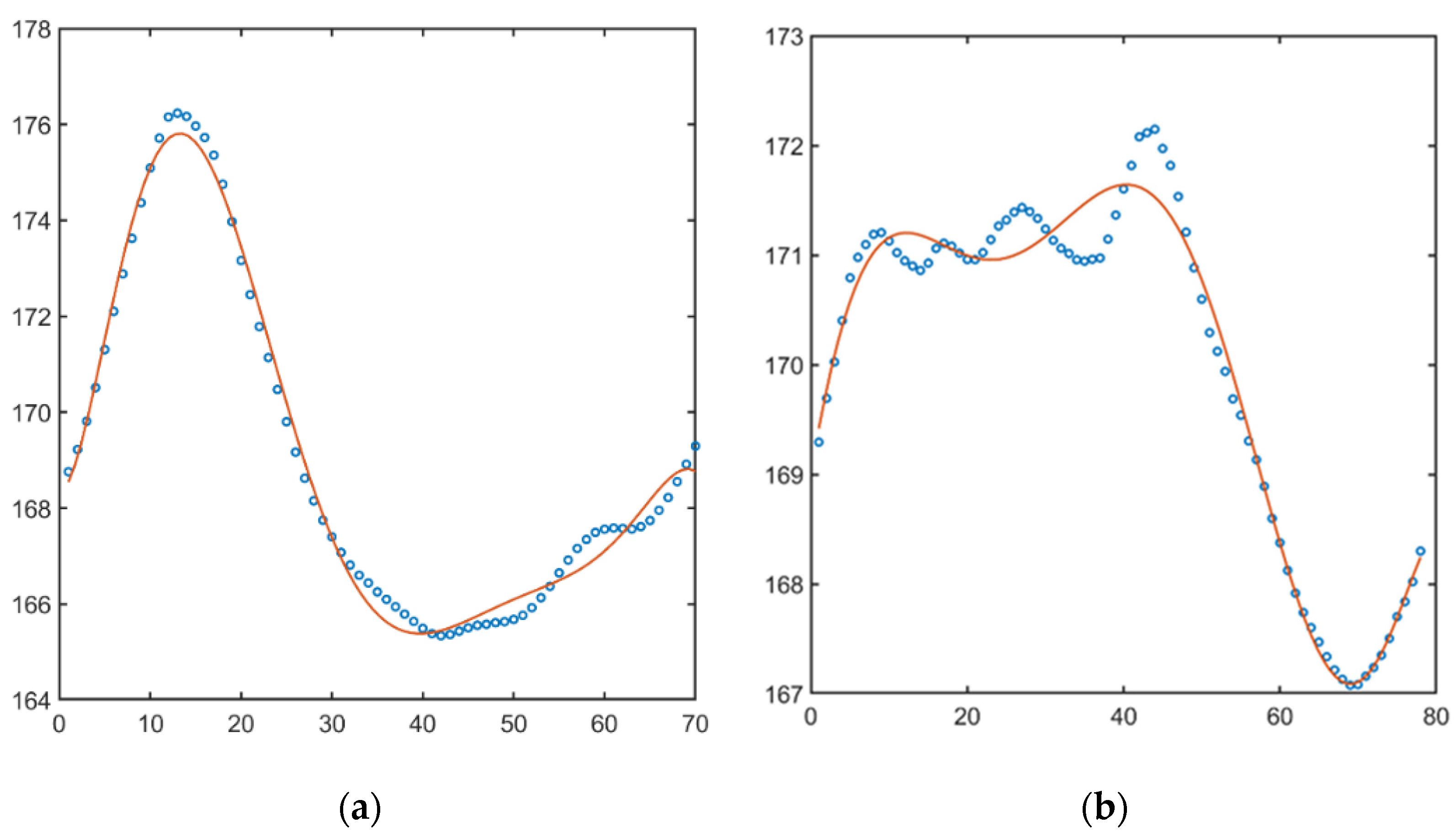
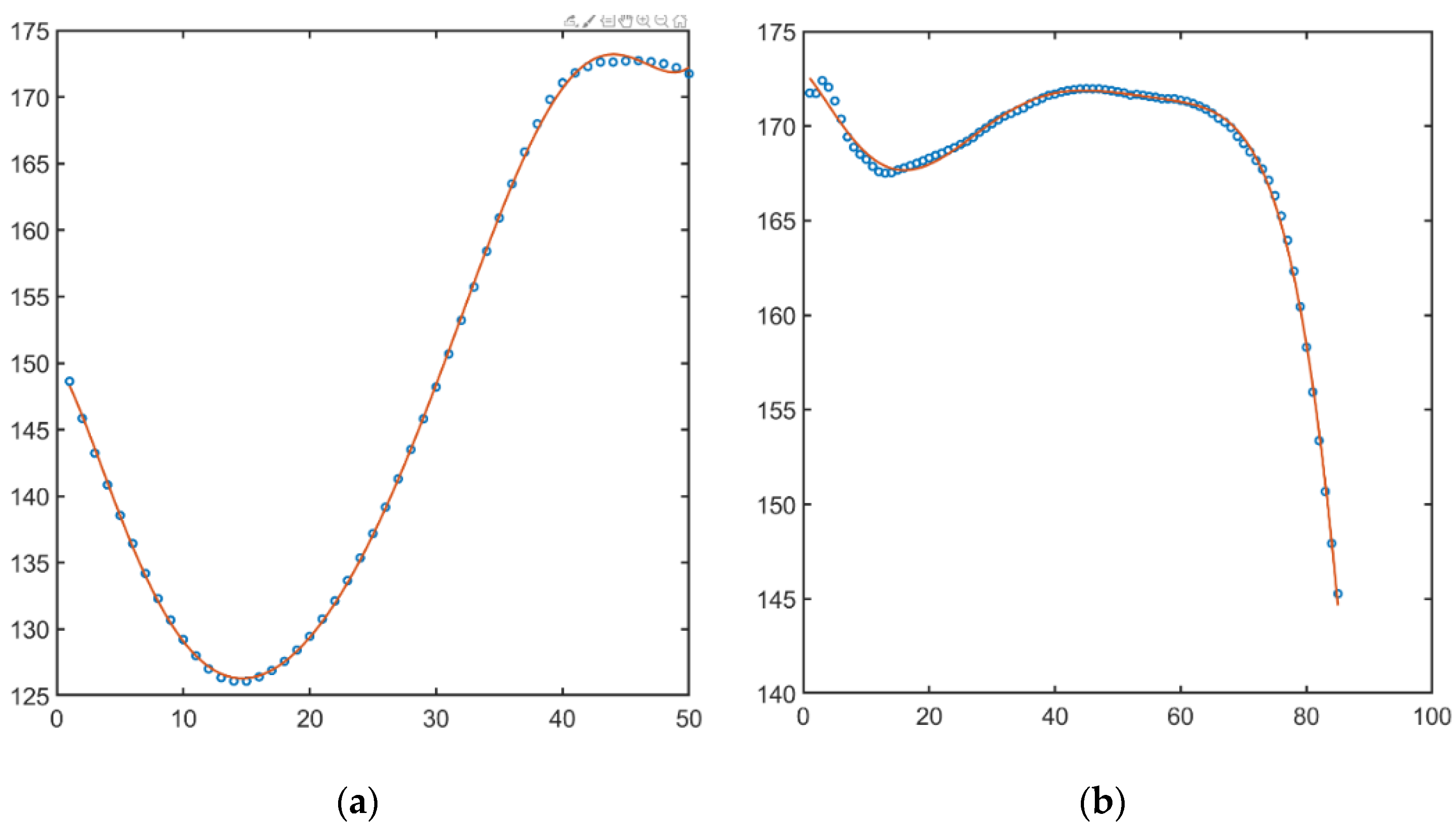
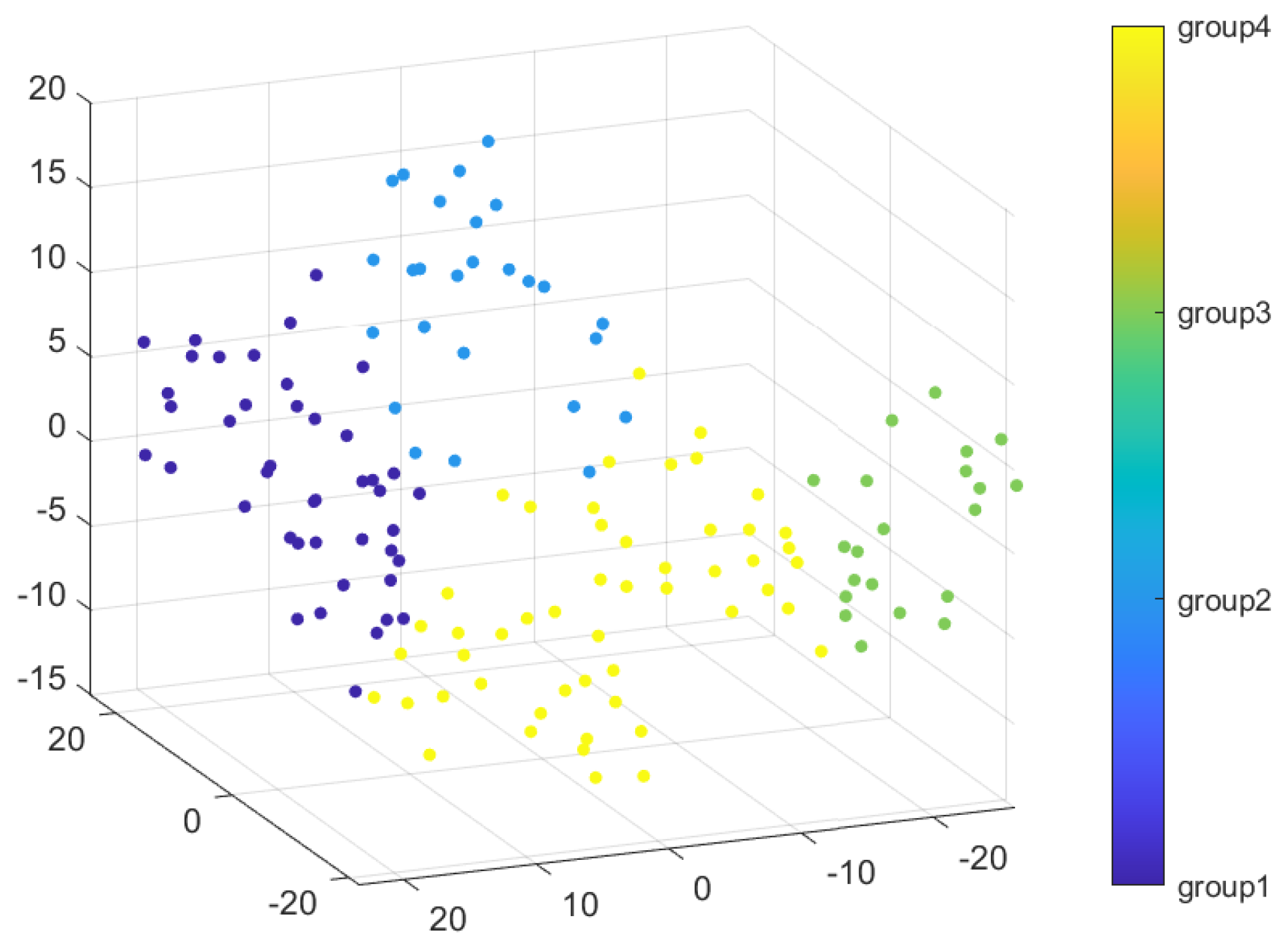

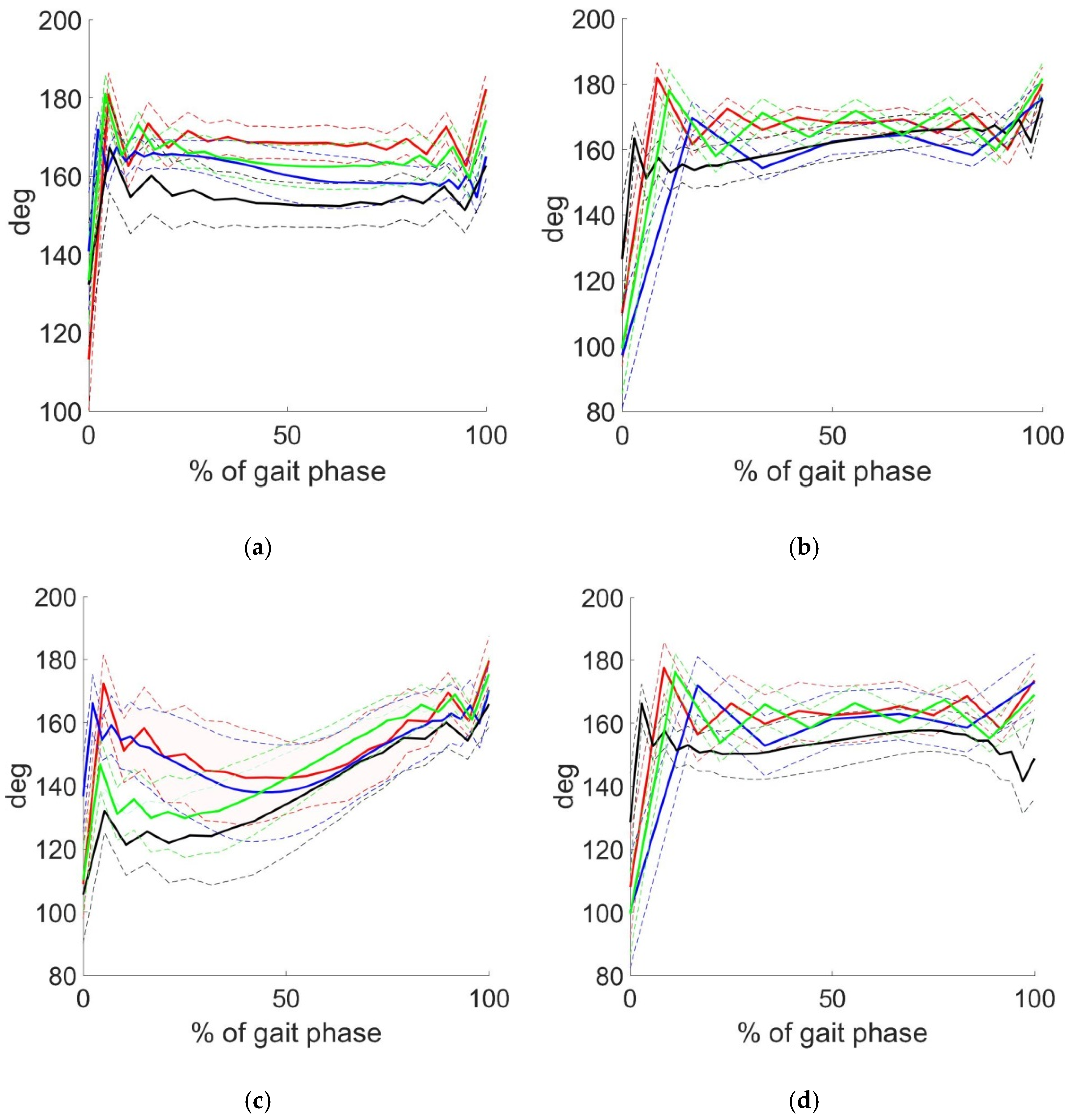
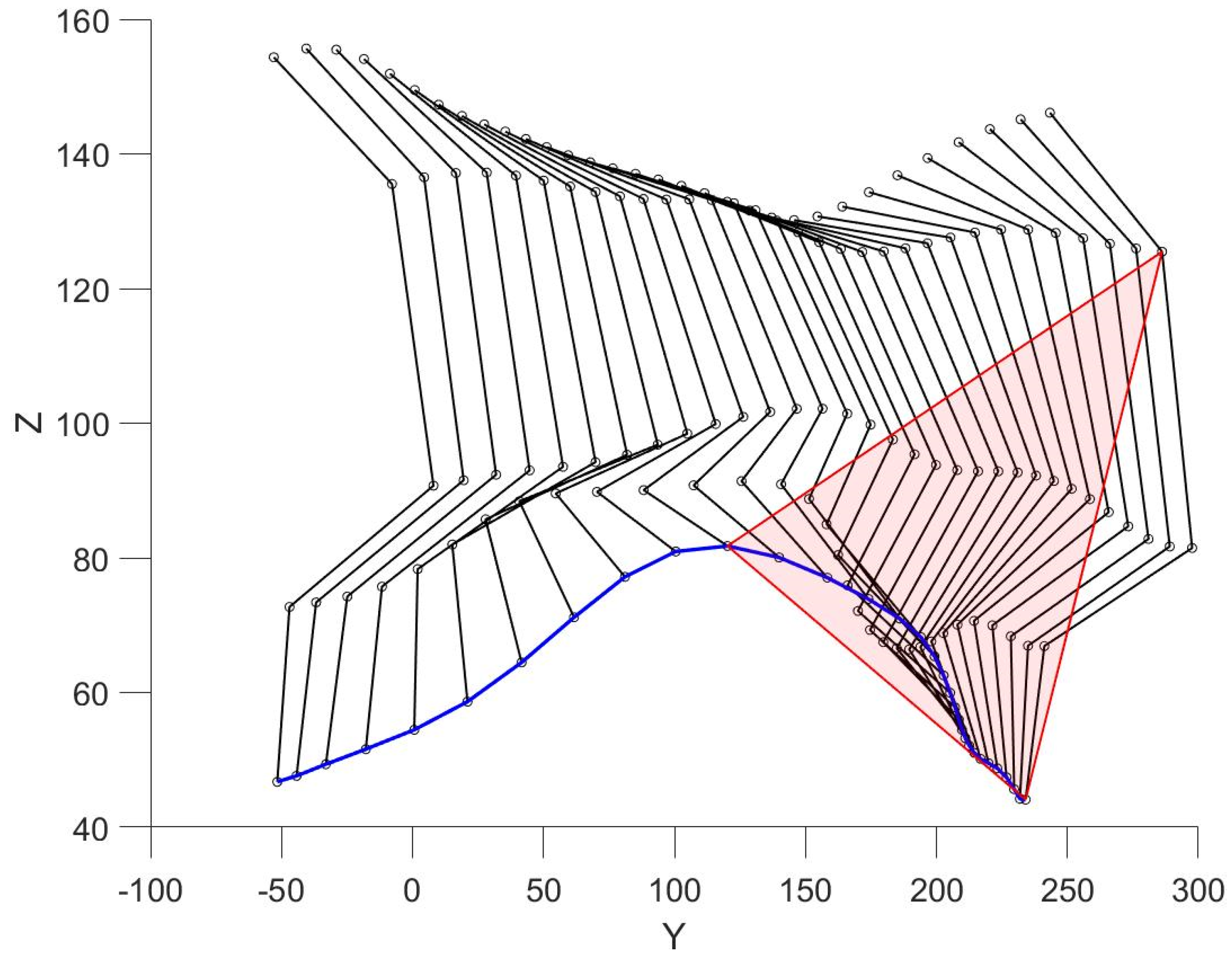
| Group | Hip Angle | Knee Angle | Subject ID | Gait Type ID | ||
|---|---|---|---|---|---|---|
| Swing, ° | Stance, ° | Swing, ° | Stance, ° | |||
| 1 | 169 ± 2 | 168 ± 2 | 153 ± 4 | 163 ± 4 | F1, M1, M2 | T2, T6, T8 |
| 2 | 161 ± 3 | 161 ± 2 | 150 ± 4 | 161 ± 5 | F2 | T3, T8 |
| 3 | 155 ± 5 | 161 ± 4 | 139 ± 8 | 153 ± 5 | F3 | T2 |
| 4 | 165 ± 4 | 167 ± 3 | 147 ± 5 | 161 ± 4 | M1, M2, M3 | T1, T9 |
Publisher’s Note: MDPI stays neutral with regard to jurisdictional claims in published maps and institutional affiliations. |
© 2022 by the authors. Licensee MDPI, Basel, Switzerland. This article is an open access article distributed under the terms and conditions of the Creative Commons Attribution (CC BY) license (https://creativecommons.org/licenses/by/4.0/).
Share and Cite
Smirnova, V.; Khamatnurova, R.; Kharin, N.; Yaikova, E.; Baltina, T.; Sachenkov, O. The Automatization of the Gait Analysis by the Vicon Video System: A Pilot Study. Sensors 2022, 22, 7178. https://doi.org/10.3390/s22197178
Smirnova V, Khamatnurova R, Kharin N, Yaikova E, Baltina T, Sachenkov O. The Automatization of the Gait Analysis by the Vicon Video System: A Pilot Study. Sensors. 2022; 22(19):7178. https://doi.org/10.3390/s22197178
Chicago/Turabian StyleSmirnova, Victoriya, Regina Khamatnurova, Nikita Kharin, Elena Yaikova, Tatiana Baltina, and Oskar Sachenkov. 2022. "The Automatization of the Gait Analysis by the Vicon Video System: A Pilot Study" Sensors 22, no. 19: 7178. https://doi.org/10.3390/s22197178
APA StyleSmirnova, V., Khamatnurova, R., Kharin, N., Yaikova, E., Baltina, T., & Sachenkov, O. (2022). The Automatization of the Gait Analysis by the Vicon Video System: A Pilot Study. Sensors, 22(19), 7178. https://doi.org/10.3390/s22197178







